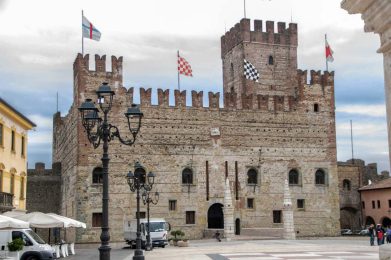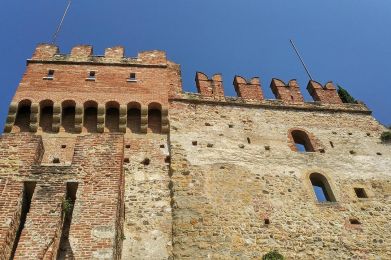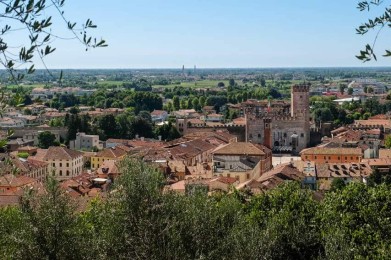The Castle of Marostica is actually a unique fortified complex consisting of two castles-the Lower Castle and the Upper Castle-connected by a scenic wall about 1,800 meters long, embracing the town in a harmonious and strategic design. Located in the heart of the province of Vicenza, this complex encompasses centuries of history, military architecture and civil transformations.
The Lower Castle: the fortress of the plains
Built in the 14th century by the Scaligeris of Verona, the Lower Castle (or “Castello da Basso”) was born as a military fortress and tollhouse in a strategic lowland location. With the passage of Marostica under the Venetian Republic in the 15th century, the building became the seat of political and judicial power, gradually transforming into an elegant stately palace. During the modern age, it housed military commands, offices and even a theater, which has since disappeared. Restored several times since the 1930s, it is now fully open to visitors and is one of the beating hearts of the historic center, overlooking the famous Chess Square.
The Upper Castle: the fortress on the hill
In contrast to the flat layout of the Lower Castle, the Upper Castle dominates the city from the top of Pausolino Hill. Also built in the 14th century, it has a square plan with four corner turrets and a massive central tower, but its history has roots even farther back: in fact, a Roman fortification stood on the same site, already documented in 1262. After being damaged in the War of the League of Cambrai, the fortress was gradually abandoned in favor of the lower site.
The city walls and city gates
The two fortresses are connected by an imposing crenellated wall, built in 1372 at the behest of Cansignorio della Scala. Along the walls are patrol walkways, once used for surveillance. Access to the historic center is through four monumental gates: Porta Vicentina, Porta Breganzina, Porta Bassanese and the Upper Castle Gate. A fifth, more recent opening (1934-1935) was created to facilitate access from the old railway station.
The Doglione: the Middle Rock
Opposite the Lower Castle is the Doglione, also known as “Rocca di Mezzo,” now home to the “Prospero Alpini” civic library. First mentioned in a document from 1218, it was originally a tollhouse, a function later absorbed by the new Scaliger castles. It regained relevance under Venetian rule.
A city enclosed in a chessboard
Marostica Castle, in its intricate structure, is not only a testament to medieval military engineering, but also a symbol of the city’s historical and cultural identity. The famous Chess Square, overlooked by the Lower Castle, is transformed every two years into a real living chessboard reenacting the legendary 15th-century chess game-an event that attracts visitors from all over the world and perfectly embodies the noble and theatrical spirit of Marostica.






